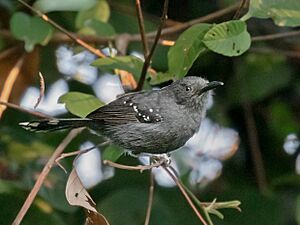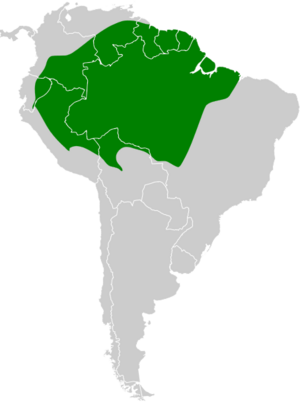Grey antbird facts for kids
Quick facts for kids Grey antbird |
|
|---|---|
 |
|
| Male | |
| Conservation status | |
| Scientific classification | |
| Genus: |
Cercomacra
|
| Species: |
cinerascens
|
 |
|
The grey antbird (Cercomacra cinerascens) is a cool little bird from the Thamnophilidae family, also known as antbirds. You can find it living in the warm, wet forests of South America. It calls places like Bolivia, Brazil, Colombia, Ecuador, French Guiana, Guyana, Peru, Suriname, and Venezuela its home.
This bird prefers to live in subtropical or tropical lowland forests. These are usually very moist and full of trees.
What Does the Grey Antbird Look Like?
This bird is about 14.5 cm (5.7 in) long, which is roughly the size of a small sparrow. The male grey antbird is mostly grey, with a slightly darker grey tail. It has neat white spots on its wing coverts (the feathers covering the base of the wings). It also has broad white spots near the tips of its tail feathers.
The female looks a bit different. She is olive-brown on her back and a pale, sandy-brown on her belly. Her tail is a darker brown. Just like the male, she has white spots on her wings and tail.
How Scientists Name the Grey Antbird
Scientists use a special system to name and group living things. This is called taxonomy. The grey antbird was first described by an English zoologist named Philip Sclater in 1857. He studied a specimen, which is a sample of an animal, found near the Rio Napo in Ecuador.
Sclater gave it the scientific name Formicivora cinerascens. The word cinerascens comes from Late Latin and means "ashen," which describes its grey color. Later, this antbird was placed in the genus Cercomacra. Sclater himself introduced this genus in 1858.
Scientists have found that there are four slightly different groups, called subspecies, of the grey antbird:
- C. c. cinerascens: This group lives in southeast Colombia, south Venezuela, east Ecuador, northeast Peru, and northwest Amazonian Brazil.
- C. c. immaculata: You can find this group in east Venezuela, the Guianas, and northeast Brazil.
- C. c. sclateri: This subspecies lives in east Peru, northwest Bolivia, and southwest Amazonian Brazil.
- C. c. iterata: This group is found in southeast Amazonian Brazil and northeast Bolivia.


